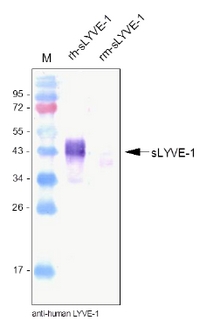LYVE1 Rabbit Polyclonal Antibody
Specifications
| Product Data | |
| Applications | ELISA, FC, IF, IHC, WB |
| Recommended Dilution | ELISA (1-15 µg/ml). Western blot (1-2 µg/ml). FACS analysis (3-20 µg/ml). Immunohistochemistry on Frozen Sections (6-30 µg/ml). Please Note: For use on Paraffin Embedded Sections the Affinity Purified antibody (Cat.-No DP3500PS) is recommended. |
| Reactivities | Human |
| Host | Rabbit |
| Clonality | Polyclonal |
| Immunogen | Recombinant Human soluble LYVE-1 (24-232) produced in insect cells. |
| Specificity | The antibody recognizes LYVE-1. |
| Formulation | 5mM PBS, pH 7.2 without preservatives or stabilizers State: Purified State: Lyophilized purified IgG fraction |
| Reconstitution Method | Restore in sterile water to a concentration of 0.1-1.0 mg/ml. |
| Purification | Protein A Chromatography (+ his tag depleted) |
| Database Link | |
| Background | LYVE-1 has been identified as a major receptor for HA (extracellular matrix glycosamino-glycan hyaluronan) on the lymph vessel wall. The deduced amino acid sequence of LYVE-1 predicts a 322-residue type I integral membrane polypeptide 41% similar to the CD44 HA receptor with a 212-residue extracellular domain containing a single Link module the prototypic HA binding domain of the Link protein superfamily. Like CD44, the LYVE-1 molecule binds both soluble and immobilized HA. However, unlike CD44, the LYVE-1 molecule colocalizes with HA on the luminal face of the lymph vessel wall and is completely absent from blood vessels. Hence, LYVE-1 is the first lymph-specific HA receptor to be characterized and is a uniquely powerful marker for lymph vessels themselves. |
| Synonyms | LYVE1, CRSBP-1, CRSBP1, HAR, XLKD1 |
| Note | Protocol: Double staining LYVE-1/CD31 on Humanen Cryo-Sections - dry Cryo sections for 1h at RT - fix sections for 10 min at –20°C in MeOH - wash 3x3 min in PBS at RT - block 20 min in 10% goat serum in PBS - 1. AB over night at 4°C in 10% goat serum in PBS [anti h -LYVE-1 10μg/ml and anti h-CD31 1:50 (Klon JC70A)] - wash 3x3 min in PBS at RT - 2. AB 30 min at RT in PBS [goat anti rabbit IgG (H+L) CY3 1:500 and goat anti mouse biotin 1:500] - wash 3x3 min in PBS at RT - staining of nucleus 10 min at RT in Hoechst Dye 1:5000 in PBS - wash 3x3 min in PBS at RT - cover with DAKO Fluorescent Mountingmedium Staining protocol for Rabbit polyclonal anti-LYVE-1 on Paraffin Sections (Human Spleen) The specimens (maximum edge length 0.5cm) are fixed for 24 hours (or longer) in 3.7% formalin in tap water (low pH during fixation is advantageous). Embedding is done in paraffin carefully avoiding temperatures exceeding 60°C. The sections are cut and deposited on silanized slides and dried at 60°C overnight. They are then de-paraffinized and pretreated with protease XIV (Sigma No. P-5147) at 0.5mg/ml in TBS pH7.6 for 15min at room temperature. The primary polyclonal antibodies are applied at 1:100 to 1:150 in PBS/1%BSA/0.1%NaN3 overnight. Subsequently, the Vector anti-rabbit ABC kit for peroxidase is used according to the manufacturer´s instructions and the presence of peroxidase revealed by diaminobenzidine reaction. Note: The antibodies have to be used at a tenfold higher concentration on paraffin sections in comparison to cryo sections. High temperature antigen retrieval does not work, but protease pretreatment is mandatory. The protocol was established at the laboratory of: Prof. Dr. Birte Steiniger Institute of Anatomy and Cell Biology Robert-Koch-Str.8 D-35037 Marburg Germany E-mail: steinigb@staff.uni-marburg.de |
| Reference Data | |
Documents
| Product Manuals |
| FAQs |
| SDS |
{0} Product Review(s)
0 Product Review(s)
Submit review
Be the first one to submit a review
Product Citations
*Delivery time may vary from web posted schedule. Occasional delays may occur due to unforeseen
complexities in the preparation of your product. International customers may expect an additional 1-2 weeks
in shipping.






























































































































































































































































 Germany
Germany
 Japan
Japan
 United Kingdom
United Kingdom
 China
China









